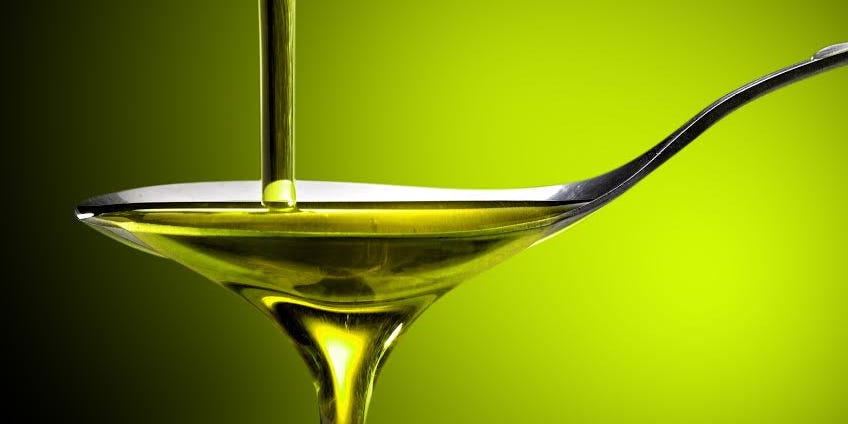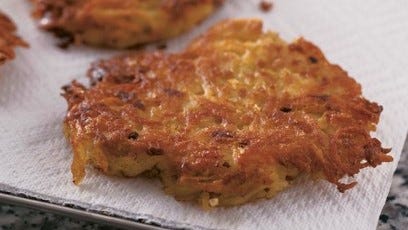Chanukah, from the Hebrew word meaning ‘dedication’, is the celebration of light, victory and fried food…
The customary eating of latkes and doughnuts during the eight-day festival of light is steeped in history and culinary tradition. It serves as a delicious reminder of the miracle that kept the branched candelabra in the 2nd Temple of Jerusalem alight for eight full days, when only a single cruse of oil, barely sufficient for one day was found by the Maccabees, the Jewish rebels who led the revolt again the Assyrians to restore the Temple, in 165 BCE.
Latkes and doughnuts have assumed their relatively recent reputation as the traditional fayre of Chanukah. The older custom of eating dairy, specifically cheese, is linked to the apocryphal tale of the Jewish heroine Judith, whose beauty and culinary charm saved the city of Bethulia in ancient Israel from the Assyrian army, and allowed for the Maccabeans to take victory. According to the story, Judith invited the General to dine with her, whereupon she fed him an abundance of salty cheese which to quench his severe thirst, he washed down with copious amounts of alcohol. Intoxicated to unconsciousness, Judith cut off his head, allowing the Israelites to attack the Assyrians, who fled in fear. It is therefore from this biblical tale and found subsequently to be written in Jewish Code of Law, that cheese was assumed to be the original celebratory food of Chanukah.
For centuries, Sephardic and Mizrachi Jews simply fried lumps of cheese in hot oil. Following the exile of the Sephardic Sicilian Jews from Spain in 1492, ricotta filled pancakes called cassola were introduced to the Jews of Northern Italy as the Chanukah fayre, which was perceived as the original latke. The Ashkenazim seemingly placed the cheese inside a soft, thin wheat-based pancake which they called a blintz and which ostensibly shaped the latke. Milk to make the cheese, was expensive for the Ashkenazim to buy and coupled with the dietary laws of mixing meat and dairy being sacred to all Jewish kitchens, the prohibited frying of cheese in the cheaper rendered poultry schmaltz, paved the way for the potato latke, which was to become the main staple of the Ashkenazi diet, and the culinary symbol of the festival of Chanukah.
The latke, whether made from potato, other root vegetables, or cheese, served with an apple sauce or sour cream dip, is merely half of the Chanukah culinary story, the other half being much sweeter and usually doused in icing sugar or a floral syrup, have too become truly representative of this festival.
Round pieces of spongy, yeasted dough fried in oil, filled with fruit jams or nutty creams fulfil the modern Israeli term sufganiot, commonly known in Western communities as doughnuts. The Ashkenazim, Sephardim and Mizrachim have all laid claim to their own version of the iconic pieces of ‘fried dough’, symbolic of this cultural festival and in some Jewish kitchens, more iconic than the potato latke. From the Aramaic language sfogga and sofgan, meaning a ‘spongy dough’, this aptly describes the doughnuts absorbent texture and its ability to soak up flavour. In Yiddish it was called the pontshke, which when the Ashkenazim took to America in the mid-1900’s was rebranded as the ‘jelly doughnut’. In spite of the fruit preserve being pronounced as jelly or jam, the large circle of fried yeasted dough was generously filled with a sticky, fruity conserve and drenched in icing sugar, and became the popular global Chanukah snack.
It was during the 1920’s that doughnuts sought their popularity in Israel, heralded by the country’s General Organisation of Workers, known as the Histadrut, in what was then British run Palestine. According to American food history writer for Time magazine, Emelyn Rude, “sufganiot were rather more challenging to make than latkes” and so in the winter months when labour was in short supply, paid work was created for the hundreds of Histadrut members, preparing, shaping and frying sufganiot for the eight-day festival, as well as selling and transporting them up and down the country. So successful was the crusade to publicise the doughnut as festive fayre, that over one hundred years later, they are as synonymous with Chanukah as the lighting of the candles, and with a contemporary face lift, a far cry from the simplistic piece of golden dough with a little bright red jam oozing out and a dusting of icing sugar. Although the yeasted dough remains round, pillowy and golden, the fillings and toppings have elaborated to such extravagant heights fusing flavours from all strands of the Jewish cuisine, paling the humble jam doughnut into insignificance, after centuries of customary eminence.
The Sephardi and Mizrachi communities all celebrate Chanukah with their own familial recipe for a yeasted dough ball, that they delight in feeding their families on each year. Handed down through the echelons of time, flavours specific to their region and culinary roots are added to the dough, believed without a doubt to be the tastiest and most authentic to the biblical origins, as each recipe echoes the myriad of cultural influences and traditions practised by their non-Jewish neighbours and from where they assumed their ownership.
Zalabia is the name given to pieces of fried dough or fritters, that originated in the Muslim ruled Iberian Peninsula, and have for centuries been eaten by Christians at the holiday of Epiphany, Arabs on Eid al-Ghtas and Sephardic Jews on Chanukah. Zalabia batter is thin, comprising of eggs, flour, yeast and milk, and depending on the culture and region, flavoured and shaped accordingly. Iraqi Jews pipe the batter into the hot oil in beautiful spirals with a lattice decoration, called zingula or Iraqi funnel cakes. Once deep fried in oil, they are saturated in a fragrant syrup whilst still warm, flavoured with rose, geranium or orange blossom, according to the preference of the cook.
Morsels of fried dough termed awameh, meaning ‘to float’ in Arabic, were served to the Turkish caliphate dynasty by the Ottoman cooks, indulgently flavoured with intoxicating notes of saffron or cardamom, and filled with harmonious flavours of dates and marzipan before being dusted lightly with a soft, powdery sugar. Aptly named in medieval Arab kitchens, these light, fluffy balls of dough, filled with sweet treats for the empire’s sovereign, were tossed into hot oil, whereupon they instantly puffed up and floated to the surface. These popular little fritters were known in more affluent circles as as Luqaymat Al -Qadi, meaning ‘judges’ morsel or mouthful’ which once the Mizrachi Jews settled in the Eastern Mediterranean and parts of the Levant, adopted as their Chanukah doughnut. They are served laced with honey, smothered in cinnamon sugar or sitting in a pool of fragrant syrup, and like all the Chanukah food, fried in oil, simply delicious…
Thank you to all my subscribers for your tremendous support throughout 2024…
If you want to receive more news about my forthcoming book, delicious recipes and much more in 2025, please consider upgrading and take advantage of this festive offer…
To all my paid subscribers, you will receive shortly, a delicious Chanukah recipe for the traditional floaters ‘awameh’ given to me by the 2014 Israeli Masterchef winner Nof Atamna.
Happy holidays to you all and however or wherever you are celebrating, enjoy the festive fayre…








